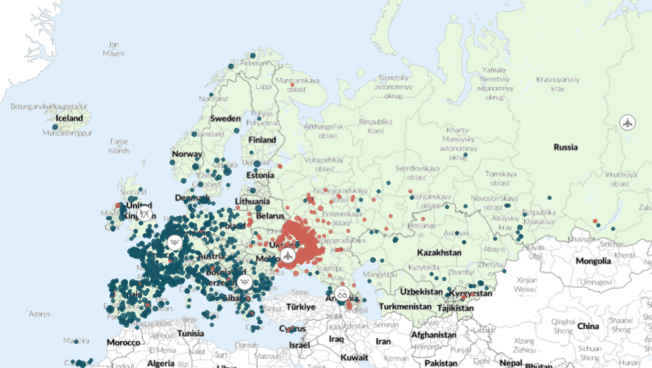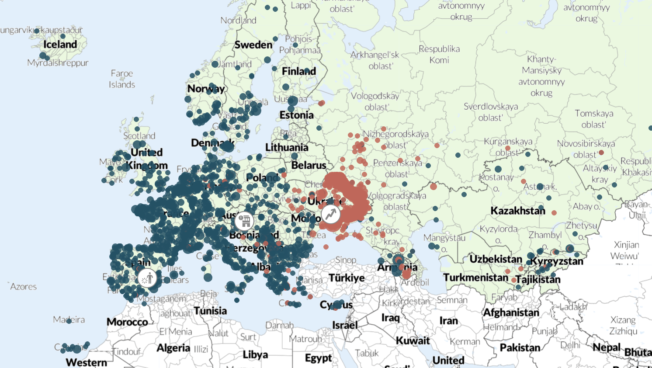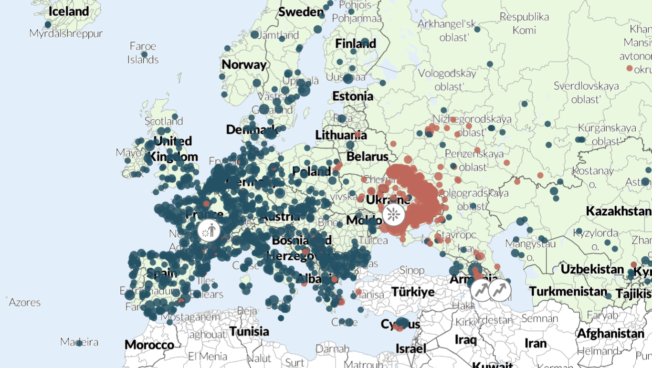Regional Overview
Europe and Central Asia
July 2025
Posted: 4 July 2025
In this Regional Overview covering June 2025
- Europe: Coordinated demonstrations challenge mass tourism
- Georgia: Opposition leaders imprisoned as the government crackdown intensifies
- Russia-Ukraine: The air war escalates as Russia steps up its offensive
- Serbia: Clashes and arrests take place amid demands for snap elections
- United Kingdom: Anti-migrant and sectarian disorder breaks out in Northern Ireland
Europe: Coordinated demonstrations challenge mass tourism
On 15 June, ahead of the summer tourist season, coordinated protests erupted across Western Europe as locals pushed back against the mounting pressures of mass tourism. At the call of the Southern Europe Against Touristification Network, activists took to the streets in at least 16 locations across Spain, Italy, and Portugal, denouncing the toll of tourism on housing, public services, the environment, and daily life.1Ashifa Kassam, “Campaigners mount coordinated protests across Europe against ‘touristification,’” The Guardian, 15 June 2025 Part of a broader trend gaining momentum in recent years, the June protests made the second quarter of 2025 the most active period for anti-tourism mobilization — or calls for alternative development models — in the region since January 2020, when ACLED began tracking these events. Building on similar protests in the spring and summer of 2024, demonstrators voiced mounting frustration with spiraling rents, overwhelmed coastlines, and the steady erosion of livability in destinations that are increasingly shaped by the tourism industry at levels that now exceed pre-pandemic levels.2UN Tourism, “International tourism recovers pre-pandemic levels in 2024,” 21 January 2025
Spain, followed by Italy and France, has seen the highest number of tourism-related demonstrations since 2022, according to ACLED data. Not coincidentally, all three rank among the world’s most visited countries, according to the United Nations World Tourism Organization,3UN Tourism, “Global and regional tourism performance,” 4 April 2025 highlighting the growing tension between the economic gains and local pushback. These tensions often play out between residents and public authorities, who tend to highlight tourism’s economic benefits. In Venice, for instance, grassroots committees challenged the city’s decision to host Amazon founder Jeff Bezos’ high-profile wedding in June, which was criticized by opponents as a symbol of the city’s transformation into a mere backdrop for elite tourism.4Colleen Barry and Luca Bruno, “Bezos and Sanchez arrive in Venice as protesters say their wedding highlights wealth inequality,” The Associated Press, 26 June 2025 Nevertheless, the protests have remained largely peaceful, relying on spectacle and symbolism rather than confrontation.5Gabe Castro-Root, “Protests in Europe Target Mass Tourism With Squirt Guns and Roller Bags,” The New York Times, 15 June 2025
Georgia: Opposition leaders imprisoned as the government crackdown intensifies
In late June, Georgian judges sentenced six opposition leaders to between seven and eight months in prison for their refusal to testify before a parliamentary commission investigating the rule of the United National Movement (UNM) between 2004 and 2012. Prosecuting and effectively banning UNM and other opposition groups was a campaign pledge of the ruling Georgian Dream (GD) party ahead of contested parliamentary elections in October 2024. The subsequent suspension of accession talks with the European Union sparked ongoing but now low-key protests, mostly in the capital, Tbilisi. Since replacing the pro-opposition president with a former footballer in December to enact legislation, the GD-dominated parliament has restricted freedom of assembly,6Venice Commission of the Council of Europe, “Georgia – Urgent Opinion on amendments to the Code of administrative offences and the Law on assemblies and demonstrations,” 3 March 2025 expelled opposition members of parliament who have refused to take up seats or have boycotted the legislature,7Mikheil Gvadzabia, “Georgian Dream expels 49 opposition MPs and forms its own ‘healthy opposition’ group in parliament,” Open Caucasus Media, 5 February 2025 amended treason provisions to prosecute UNM, and replaced the recently adopted foreign agents law with an exact copy of the United States Foreign Agents Registration Act, but applied to civil society and media rather than lobbyists.8Civil Georgia, “GD Rubber Stamps FARA, Broadcasting Law Changes, Revives Treason, Removes Gender, Excludes CSOs,” 1 April 2025 The decapitation of the opposition leaves it rudderless ahead of local elections in October.
Russia-Ukraine: The air war escalates as Russia steps up its offensive
On 1 June, Ukrainian military intelligence attacked four Russian military airfields in the Ryazan, Ivanovo, Murmansk, and Irkutsk regions with 117 drones. For strikes in the latter two remote regions, the drones were smuggled into Russia and launched off trucks. A strike attempt in the Far East’s Amur region failed due to premature detonation en route to an airbase, killing the unwitting truck driver, who is the only confirmed civilian casualty.9Chris Boccia, “Zelenskyy says Russian drivers ‘didn’t know anything’ about role in audacious drone attack,” ABC News, 7 June 2025 Ukrainian officials claimed that 41 Russian warplanes were damaged, half beyond repair. Open source analysts and a NATO official suggested a dozen planes may have been destroyed.10Meduza, “Ukraine’s ‘Spiderweb’ operation damaged 40 Russian aircraft, destroying at least 10–13, senior NATO official says,” 4 June 2025 To preclude further attacks, the Russian military moved nuclear-capable strategic bombers further east.11Agentstvo, “Russia moves its bombers to the Far East after Ukrainian strikes,” 12 June 2025 (Russian) Later in June, ACLED records at least five other drone strikes on military airfields across European Russia, possibly damaging six fighter jets.
The 1 June strikes coincided with several attempts to derail trains by planting explosives on overpasses and tracks. On the eve of the string of incidents, a bridge likely blown by Ukrainian operatives collapsed on a moving passenger train in the Bryansk region, killing seven civilians and injuring 127 others.
In response, Russian forces launched barrages of long-range missiles and primarily drones at Ukraine. They sent ever larger numbers of the latter throughout June, including unarmed decoy drones to overwhelm Ukrainian air defense.12Yuliia Taradiuk, “Smashing previous monthly record, Russia launches 5,337 kamikaze drones against Ukraine during June,” The Kyiv Independent, 30 June 2025 Kyiv city and the surrounding region were subjected to over 40 strikes — the highest number since February. The deadliest bombardment occurred on 17 June and lasted for nine hours. Russian missiles and drones, including those carrying cluster munitions, hit apartment blocks, killing 28 civilians and wounding scores of others. A week earlier, a Russian drone damaged the 11th-century Saint Sophia Cathedral in Kyiv’s city center.
Meanwhile, Russia increased the pace of its grinding ground offensive in Ukraine. The Russian military claimed to have occupied over 20 settlements in the Donetsk region — twice the average of the previous three months — in an attempt to envelop Pokrovsk and Kostiantynivka in the central part of the region. Russian forces also claimed to have gained a foothold in the neighboring Dnipropetrovsk region.13Pjotr Sauer, “Russia has taken first village in Ukraine’s Dnipropetrovsk, state media claims,” The Guardian, 30 June 2025 Further north, following Russian President Vladimir Putin’s demand for a buffer zone14Russian news agency TASS, “Putin announces decision to create buffer zone along border with Ukraine,” 22 May 2025 after the expulsion of Ukrainian troops from Russia’s Kursk region in March, Russian forces expanded their bridgehead in Ukraine’s Sumy region but encountered resistance and stalled. A similar attempt last year in the Kharkiv region embroiled both sides in ongoing fighting on the border.
Peace talks in Istanbul on 2 June did not deliver results beyond agreements to exchange prisoners of war and fallen soldiers. Russia again demanded that Ukraine cede Crimea and four contested regions within their administrative boundaries and also demanded that Ukraine demobilize, disarm, and hold elections.15Christian Edwards et al., “Second round of Russia-Ukraine peace talks ends swiftly with no major breakthrough,” CNN, 2 June 2025 Ukraine insisted on a full ceasefire to allow for negotiations and security guarantees to discourage further Russian aggression.16Reuters, “Ukrainian proposals for June 2 talks with Russia in Istanbul,” 1 June 2025
For more information, see the ACLED Ukraine Conflict Monitor.
Serbia: Clashes and arrests take place amid demands for snap elections
In June, student-led anti-corruption demonstrations in Serbia entered their ninth month since the deadly collapse of a train station canopy in Novi Sad last November. Despite this, the number of demonstrations dropped by more than half since April compared with the peaks observed between January and March. In a leap from demanding political and criminal accountability for corruption, activists began urging early parliamentary elections.17Katarina Baletic, “Student Protesters Demand Snap Elections to Counter Corruption in Serbia,” Balkan Insight, 6 May 2025 Approximately 140,000 people gathered in Belgrade on 28 June to press for snap polls in the second-largest demonstration in Serbia’s recent history.18Vreme, “Archive of public gatherings: 140.000 people in Slavija,” 28 June 2025 After the official student-organized program concluded, groups of demonstrators remained in the city center. Some of them clashed with police who deployed tear gas, batons, and shields to disperse and subdue demonstrators.19Milica Stojanovic, “Dozens Arrested Over Clashes After Mass Protest in Serbia,” Balkan Insight, 29 June 2025 The following day, students who had attended the rally were arrested. In the days preceding the rally, police also detained several individuals on charges of plotting a coup. Among those arrested were former military and police personnel who are vocal supporters of the protest movement. Citizens responded by blocking hundreds of intersections across the country.20Jovana Gec, “Thousands set up street blockades in Serbia after arrests of anti-government protesters,” The Associated Press, 30 June 2025 The constantly shifting locations of these blockades left police largely unable to mount an effective response.21Katarina Baletic and Milica Stojanovic, “Civil Disobedience Roils Serbia Following Arrests of Protesters,” Balkan Insight, 30 June 2025
High-profile resignations have failed to quell mounting demonstrations, and President Aleksandar Vučić has firmly rejected calls for early elections, instead emphasizing his administration’s commitment to hosting the 2027 World Exposition (EXPO). The EXPO construction project has itself become a source of corruption allegations from the opposition.22Leah Baker, “Serbian Opposition Calls to Cancel Expo 2027 in Belgrade Over Corruption Concerns,” Lawyer Monthly, 4 March 2025 The government’s increased repression may signal an intent to suppress the protest movement during the upcoming holiday season, when public attention typically wanes. The previous early parliamentary elections in late 2023 were forced by demonstrations against a culture of violence in the wake of school shootings and prompted protests over alleged electoral fraud.
United Kingdom: Anti-migrant and sectarian disorder breaks out in Northern Ireland
On 9 June, two Romanian-speaking 14-year-old boys appeared in court on charges of sexually assaulting a teenage girl in Ballymena, a town about 35 kilometers northeast of Belfast.23Maria McCann, “Teenage boys in court charged with attempted rape,” BBC, 9 June 2025 Following the hearing, a wave of anti-migration demonstrations and violence spread across Northern Ireland, reminiscent of a previous bout of anti-migrant unrest in August 2024. A vigil organized in support of the victim’s family in Ballymena descended into violence when a group of masked people split from the main event. Rioters attacked homes and businesses associated with foreigners and clashed with police. From the following day, the anti-migrant rampage continued in Ballymena and spread to other cities, including Newtownabbey, Carrickfergus, Coleraine, Portadown, and Derry. ACLED records at least 12 episodes of violence in which hundreds of masked rioters clashed with police; threw petrol bombs, fireworks, and masonry; and set vehicles and properties on fire. More than 60 police officers were injured over several nights of unrest.24Ross McKee, “Saturday night saw some ‘sporadic disturbances’, police say,” BBC, 15 June 2025 In Larne, around 100 masked youth attacked and set fire to a leisure center after rumors on social media claimed that the center was used to provide emergency housing for foreign families who had fled Ballymena.25Ben Makori and Amanda Ferguson, “Northern Ireland leisure centre hosting immigrants attacked on third night of violence,” Reuters, 12 June 2025 Meanwhile, people also took to the streets to voice their anti-migration stance peacefully. ACLED records at least 17 peaceful anti-migration demonstrations in Northern Ireland and at least three pro-migration gatherings in June.
Sectarian violence between rival Catholic and Protestant groups in Derry also broke out in June. The city witnessed unrest for three nights, beginning on 16 June, when rioters attempted to attack homes in the unionist Fountain Estate, an interface area in Derry, before police intervened and clashes broke out. Disturbances continued for the following two nights, although with decreasing intensity. Low-level sectarian tensions in the area have simmered since April, when two Catholic boys were attacked in the Waterside area of Derry by unknown assailants.
See More
See the Codebook and the User Guide for an overview of ACLED’s core methodology. For additional documentation, check the Knowledge Base. Region-specific methodology briefs can be accessed below.
Links:
For additional resources and in-depth updates on the conflict in Ukraine, check our dedicated Ukraine Confict Monitor.







